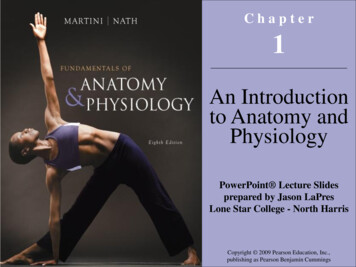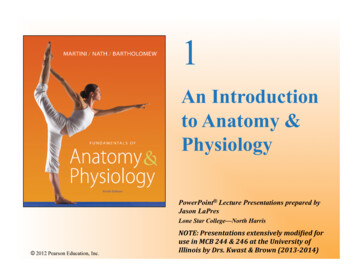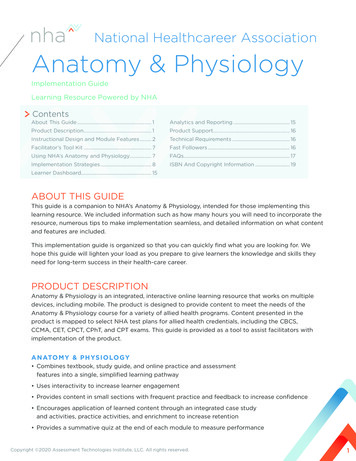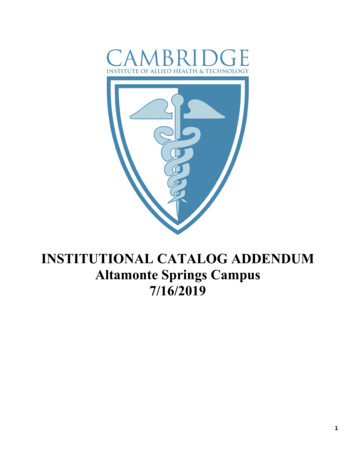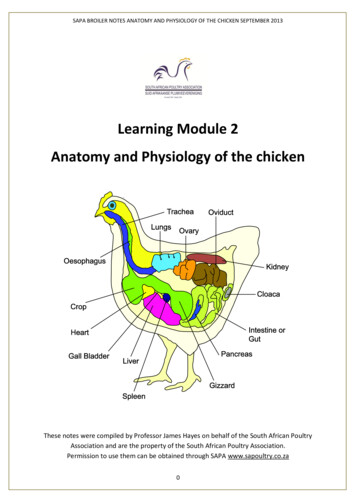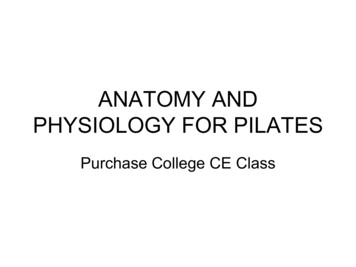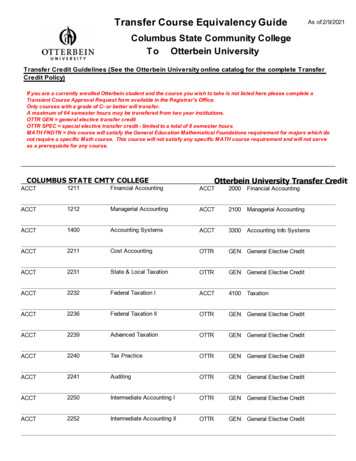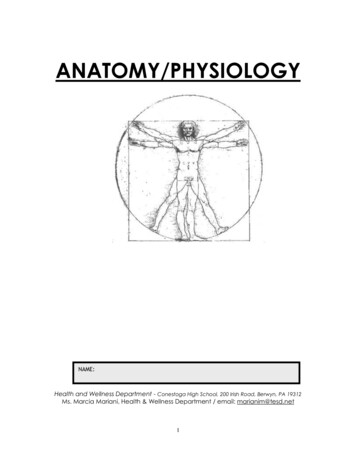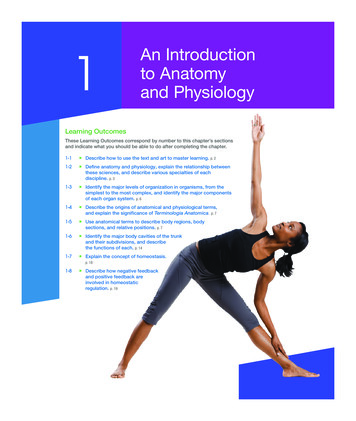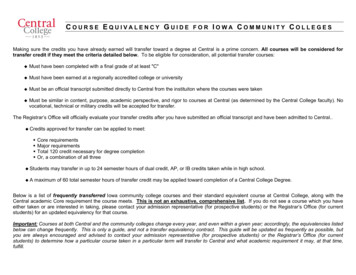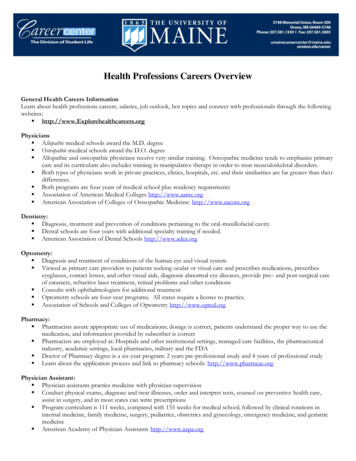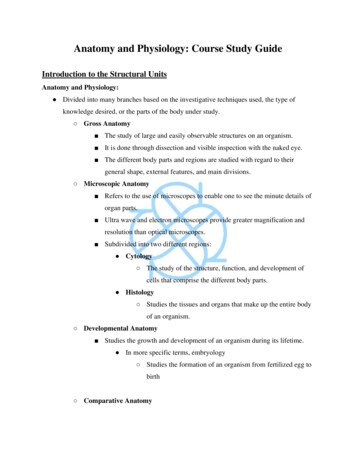
Transcription
Anatomy and Physiology: Course Study GuideIntroduction to the Structural UnitsAnatomy and Physiology: Divided into many branches based on the investigative techniques used, the type ofknowledge desired, or the parts of the body under study. Gross Anatomy The study of large and easily observable structures on an organism. It is done through dissection and visible inspection with the naked eye. The different body parts and regions are studied with regard to theirgeneral shape, external features, and main divisions. Microscopic Anatomy Refers to the use of microscopes to enable one to see the minute details oforgan parts. Ultra wave and electron microscopes provide greater magnification andresolution than optical microscopes. Subdivided into two different regions: Cytology The study of the structure, function, and development ofcells that comprise the different body parts. Histology Studies the tissues and organs that make up the entire bodyof an organism. Developmental Anatomy Studies the growth and development of an organism during its lifetime. In more specific terms, embryology Studies the formation of an organism from fertilized egg tobirth Comparative Anatomy
The different body parts and organs of humans can be studied with regardto similarities with and differences from others in the animal kingdom. Systematic Anatomy The study of the structure of various organs or parts that comprise aparticular organ system. Specific terms in this area: Dermatology Study of the integumentary system(skin, hair, and nails). Endocrinology Study of the endocrine or hormonal system. Neurology Study of the nervous system.Anatomical Terminology: In the study of anatomy and physiology, special words are used to describe the specificlocation of a structure, organ, or the relative position/direction of one body part to another Anatomical position A human being is standing erect, with face forward, arms at the side, andpalms forward. Anterior or ventral Means “front” or “in front of” Examples: The knees are located on the anterior surface of the human body. A ventral hernia may protrude from the front or belly of theabdomen. Posterior or dorsal Means “back” or “in back of” Examples: Human shoulder blades are found on the posterior surface of thebody. Cephalic and caudal
Cephalic means “skull” or “head end” of the body. Caudal means “tail end” Superior Means “upper” or “above another” Inferior Means “lower” or “below another” Medial “Toward the midline or median plane of the body” Lateral “Away” or “toward the side of the body” Proximal “Towards the point of attachment to the body” or “toward the trunk of thebody” Distal “Away from the point of attachment or origin” or “farthest from the trunk” Superficial or external “On or near the surface of the body” Deep or internal Involves damage to an internal organ. Terms referring to Body Planes and Sections Planes Imaginary anatomical dividing lines that are useful for separating bodystructures. Section A cut made in a certain direction of a certain plane. Sagittal plane Divides the body into left and right parts. Midsagittal plane The plane starts in the middle of the skull, proceeds down, bisects thesternum and vertebral column, the body would be divided equally intoright and left halves.
Coronal (frontal) plane A vertical cut at right angles to the sagittal plane, dividing the body intoanterior and posterior portions. Transverse (cross section) A horizontal cut that divides the body into upper and lower portions. Terms Referring to Cavities of the Body: Dorsal cavity Posterior cavity of the body that houses the brain and spinal column. Cranial cavity Area of the body containing the brain. Spinal cavity Area of the body containing the spinal cord. Thoracic cavity Area of the body divided into 2 cavities: the left pleural cavity contains theleft lung and the right pleural cavity contains the right lung. Abdominopelvic cavity Area below the diaphragm, with no separation between the abdomen andpelvis. Abdominal cavity Area of the body that contains the stomach, liver, gallbladder, pancreas,spleen, small intestine, appendix, and part of the large intestine. Pelvic cavity Area of the body containing the urinary bladder, reproductive organs,rectum, remainder of large intestine, and appendix. Terms Referring to Regions in the Abdominopelvic Cavity: Epigastric Upper region of the abdominal cavity, located just below the sternum. Umbilical Area located around the navel (umbilicus); the right and left lumbarregion. Hypogastric
Lower region of the abdominal area. Smaller Cavities: Orbital cavity Contains the eye and its external structures. Nasal cavity One of the pairs of cavities between the anterior nares and thenasopharynx. Oral (buccal) cavity Encloses the teeth and tongue. Human Development: Cells The basic unit of structure and function of all living things. Tissues Special cells grouped according to function, shape, size, and structure. Organs Tissues, in turn, form larger functional and structural units. Organ system Organs that are grouped together because more than one is needed toperform a function.
Chemistry of Living ThingsChemistry: The study of the structure of matter and composition of substances, their properties, andtheir chemical reactions. Biochemistry The study of the chemical reactions of living things. Matter and Energy: Matter Anything that has weight (mass) and occupies space. Exists in solid, liquid, and gas forms. Energy The ability to do work or to put matter into motion. Exists in our bodies Potential energy Stored in cells waiting to be released. Ex. laying in bed. Kinetic energy Work resulting in motion. Ex. getting out of bed. Atoms The smallest piece of an element. Invisible to the human eye. The normal atoms are made up of subatomic particles: Protons Has a positive electrical charge. Neutrons Have no electrical charge. Electrons Has a negative charge. Isotopes
Have the same number of protons but a different number ofneutrons. Radioactive Some isotopes are unstable and decay. Elements Substances that can neither be created nor destroyed by ordinary chemicalmeans. Compounds Elements combined in definite proportion by weight to form a newsubstance. Unicellular One-celled microbe Multicellular Many-celled animal or plants Organic compounds Compounds that contain the element carbon Molecules The smallest unit of a compound that still has the properties of thecompound and the ability to lead its own stable and independent existence. Chemical bonds Bonds formed when atoms share or combine their electrons with atoms ofother elements. Ionic bond Bond in which one atom gives up an electron to another atom. Covalent bond Atoms share electrons to fill their outermost levels/shells. Hydrogen bond Bond that holds water molecules by forming a bridge between thenegative oxygen atom of one water molecule and the positivehydrogen atom of another molecule. Types of Compounds:
Inorganic Made of molecules that do not contain the element carbon (C). Organic Always contain the element carbon, combined with hydrogen and otherelements. Carbohydrates Compounds of the elements carbon, hydrogen, and oxygen. Have twice as many hydrogen atoms as oxygen and carbon. Divided into 3 groups: Monosaccharides Sugars that cannot be broken down further. Also called single or simple sugars. Ex. glucose, fructose, galactose Disaccharides Known as a double sugars because it is formed from 2monosaccharide molecules by a chemical reaction calleddehydration synthesis. Polysaccharides Large, complex molecules of hundreds to thousands ofmonosaccharides bonded together in one long, chain-likemolecule. Ex. starch, cellulose, glycogen Lipids Molecules containing the elements carbon, hydrogen, and oxygen. Different from carbohydrates because they have much less oxygen inrelation to hydrogen Ex. fats, phospholipids, and steroids. Fats (triglycerides) Consists of glycerol and fatty acids and make up 95% offats in the human body. Phospholipids
Contain carbon, hydrogen, oxygen, and phosphorus. This type of lipid may be found in the cell membranes, thebrain and nervous tissue. Steroids Lipids that contain cholesterol. Cholesterol is essential in the structure of thesemipermeable membrane of the cell. Proteins Organic compounds containing the elements carbon, hydrogen, oxygen,nitrogen, and normally phosphorus and sulfur. Found in every part of a living cell. Amino acids Small molecular units that work together to build proteins in thebody. Enzymes Specialized protein molecules found in all living things. They help control the various chemical reactions occurring in acell, so each reaction occurs just at the right moment and time. Nucleic acids Important organic compounds containing the elements carbon, oxygen,hydrogen, nitrogen, and phosphorus. There are 2 groups of nitrogenous bases Pyrimidines Either cytosine or thymine Purines Either adenine or guanine
CellsProtoplasm: An aqueous solution of carbohydrates, proteins, lipids, nucleic acids, and inorganic saltssurrounded by a cell membrane.Organelles Microscopic structures within the cell having a special function or capacity. Ribosomes Submicroscopic particle attached to endoplasmic reticulum; site of proteinsynthesis in the cytoplasm of the cell. Centrosomes Tiny area near the nucleus of an animal cell; it contains two cylindricalstructures called centrioles Endoplasmic reticulum Transport system of a cell; can be smooth or rough. Mitochondria Organelle that supplies energy to the cell. Lysosomes Cytoplasmic organelle containing digestive enzymes. Peroxisomes Membranous sacs that contain oxidase enzymes. Golgi apparatus Membranous network that resembles a stack of pancakes; it stores andpackages secretions to be secreted by the cell. Cytoskeleton Internal framework of the cell consisting of microtubules, intermediatefilaments, and microfilaments. Nucleoplasm Protoplasm inside the nucleus of a cell Cytoplasm Protoplasm of the cell body, excluding the nucleus. Chromatin
When a cell reaches a certain size, it divides to form two new cells. TheDNA and protein are arranged in a loose and diffuse state. Chromosomes Nuclear material that determines hereditary characteristics. Cilia Protrusions from the cell membrane that move material across the cell’ssurface Short hair-like protrusions Flagella Protrusions from the cell membrane that allow the cell to move throughoutthe environment Singular tail like protrusions. Meiosis Process of cell division in the sex cells Ovum (from the female) and the spermatozoa (from the male) reduce theirchromosomes by half. When fertilization occurs, the two sex cells combine to form a simple cell Zygote Has full set of 46 chromosomes Mitosis First stage is the division of the nucleus Second stage is the division of the cytoplasm Orderly series of steps in which the DNA in the nucleus of the cell isequally distributed into 2 daughter cells or identical nuclei Phases Interphase The cell goes through all metabolic cellular activities tohelp in the maintenance of homeostasis. Known as the resting stage. Prophase
The two pairs of centrioles start to separate toward theopposite ends of the cell. An array of cytoplasmic microtubules form between them. The nucleus disappears Metaphase Nuclear membrane has dissolved completely. Chromatid pairs arranged in a single file. One chromatid pair per spindle fiber between the twocentrioles. Anaphase The chromatid pairs separate and are pulled apart by theshortening spindle fibers toward the centrioles. The two chromatids of each replicated chromosome arenow fully separated Telophase The chromosomes migrate to the opposite poles of the cell. They start to uncoil The nuclear membrane and and the nucleus reappear When cytoplasmic division is finished, two new daughtercells are formed. Cell death Necrosis Name given to unprogrammed death of cells and living tissue. There are many causes of necrosis Injury, infection, cancer, infarction, toxins, andinflammation. Apoptosis Orderly process by which cells intentionally die. The cell itself initiates, regulates, and executes its death with anelaborate arsenal of cellular and molecular activity. Osmosis
The diffusion of water or any other solvent molecule through a selectivelypermeable membrane.
Tissues and MembranesTissues Tissues Epithelial Tissue Cells form a continuous layer covering internal and external bodysurfaces, provide protection, and produce secretions. Squamous Epithelial Flat, irregular shaped cells. They line the heart, blood, andlymphatic vessels. Cuboidal Epithelial Cube-shaped cells, they line the kidney tubules and cover the ovaries. Columnar Epithelial
They are elongated, with the nucleus generally near thebottom and often ciliated on the outer surface. They line theducts, digestive tract, parts of the respiratory tract, andglands Connective Tissue Adipose Stores fat, acts as filler tissue, cushions and supports thebody. It is a type of loose connective tissue composed ofsaclike adipose cells. Areolar tissue Supports both nerve and blood vessels that transportnutrient materials and waste. Dense fibrous tissue
Made from closely packed white collagen fibers. It isflexible but not elastic. Has poor blood supply and healsextremely slow.Tissue Repair Primary repair of a clean wound A clean wound is a cut on the skin where infection is not present The deep layer of stratified squamous divides. New stratified squamous epithelial cells push themselves upward to thesurface of the skin. Primary repair over a large skin area Fluid will escape from the broken capillaries The fluid dries and seals the wound, scab forms The scab prevents pathogens from entering the site Epithelial cells form at the edges of the scab and continue to grow over thedamaged area until it gets fully covered Primary repair of deep tissue The edges of the wound must be sewn together with a suture A tremendous amount of of fluid will leak onto the wound Helps form a coagulation that seals the wound In 24-36 hrs the epithelial cells lining the capillaries and fibroblasts ofconnective tissue degenerate rapidly The newly formed cells remain along the edges of the wound. On the 4th-5th day fibroblast cells become very active in making newcollagen fibers.
Once the tissues come together scar tissue is visible. Secondary repair A process known as granulation occurs in a large open wound with smallor large tissue loss The process will form new vertically upstanding blood vessels These new blood vessels are surrounded by young connective tissue andwandering cells of many types Fibroblast will be quite active in the production of new collagen The large wound eventually heals but it takes a lot of time
Integumentary System Functions of the skin A covering for the underlying tissues, protecting them from dehydration, injury,and germ invasion. Helps regulate body temperature by controlling the size of the blood vessels inthe dermal layer of the skin. Helps manufacture vitamin D. The ultraviolet light on the skin is necessary forthe first stages of vitamin D formation. The site for many nerve endings A square inch contains 72ft of nerves and hundreds of receptors. Has tissues for the temporary storage of fat, glucose, water, and salts. Most ofthese substances are eventually absorbed by the blood and transported to otherparts of the body. Serves to reduce the harmful radiation contained in everyday sunlight. Has special properties that allow it to absorb drugs and many other chemicalsubstances. Structure of the skin Epidermis The outermost layer of the skin; made up of epithelial cells, with no bloodvessels present whatsoever. Dermis Known as “true skin” it is made up of connective tissue and it containssome blood vessels. Subcutaneous The fat layer of the skin Skin color as indicator of disease Redness Erythema Causes dilation of capillary network Fever, allergic reaction, and inflammation Bluish tint (grayish in darker skin tones)
Cyanosis Causes a decrease in oxygen in capillaries Heart or respiratory disease Yellow Jaundice accumulation of bile in capillaries Gallbladder or liver disease Pallor Constriction of capillaries or decrease in red blood cells Emotional stress or anemia Hair Root The part of the hair that is implanted in the skin Shaft The hair that projects from the skin’s surface Hair follicle The root embedded in an impocketing of the epidermis Alopecia A genetic predisposition that causes permanent baldness in some people. Disease conditions and nail color Liver disease White nails Kidney disease Half of nail is pink, other half is white Heart condition Nail bed is red Lung disease Yellow and thickening nails Anemia Pale nail bed Diabetes
Yellowish with a slight blush at the base Hypoxia Bluish nails Disorders of the skin Acne vulgaris (acne) is a common non contagious and chronic disorder of the sebaceousglands Dermatitis A non contagious inflammation of the skin Eczema An acute or chronic non contagious inflammatory skin disease Impetigo An acute inflammatory and contagious skin disease seen in babies andyoung children. Characterized by appearance of vesicles that rupture and develop distinctyellow crust Psoriasis A chronic non contagious inflammatory autoimmune skin diseasecharacterized by the development of dry reddish patches covered withsilvery-white scales. Ringworm A highly contagious fungal infection marked by raised, itchy, circularpatches with crusts. Urticaria (hives) A non contagious skin condition recognized by the appearance ofintensely itching wheals or welts. Herpes simplex Occurs around the face and mouth Spreads through oral contact
Genital herpes Another form of the herpes virus May appear as a blister in the genital area Skin cancer Associated with exposure to ultraviolet light Most common type of cancer in people Basal cell carcinoma The most common and least malignant type of skin cancer Usually occurs on the face Full recovery occurs in 99% of the cases Squamous cell carcinoma Arises from the epidermis and occurs most often on the scalp and lowerlip This type grows rapidly and metastasizes to the lymph nodes Chances for recovery are good only if found early Malignant melanoma Occurs in pigmented cells of the skin called melanocytes Metastasizes to other areas quickly A color or size change in a mole or wart may indicate this type The 5 year survival rate is 91% Burns Traumatic injuries that result from exposure to radiation from the sun, heat lamp,contact with boiling water, steam, fire, chemicals, or even electricity. Rule of nines Used to measure the percent of the body burned. The body is divided into 11 areas and each area accounts for 9% of thetotal body surface. Each arm is 4.5%, perineal area is 1%, each leg is 9%, etc First degree (superficial) burns Involves only the epidermis Sunburns are usually in this category
May include swelling, redness, and pain Hold burned area under cool running water for 10-15 min Healing occurs within a week Second degree (partial-thickness) burn May involve the epidermis and dermis Include pain, swelling, redness, and blistering Pain medication and dry sterile dressing applied to open skin areas Healing occurs within 2 weeks Third degree (full-thickness) burn Involves complete destruction of the epidermis, dermis, and subcutaneouslayers. Loss of skin, eschar (blackened skin), no pain because the nerve endingsare possibly destroyed Immediate hospitalization is advised Skin graft is done as soon as possible
Skeletal system Functions Supports body structure and provides shape Protects the soft and delicate organs Allows movement and anchorage of muscles Provides mineral storage The site for y2Lv5. (n.d.). Retrieved July 18, 2020, fromhttps://images.app.goo.gl/Kdw3JfXiSbgzy2Lv5 )(OpenStax College. (2013, April 5). File:609 BodySupply to the Bone.jpg. Retrieved July 18, 2020, fromhttps://commons.wikimedia.org/wiki/File:609 Body Supply to the Bone.jpg)
(OpenStax College. (2013, May 16).File:701 Axial Skeleton-01.jpg.Retrieved July 18, 2020, fromhttps://commons.wikimedia.org/wiki/File:701 Axial Skeleton-01.jpg)(Villarreal, M. R. (2007, January 4). File:Human skull front simplified (bones).svg. RetrievedJuly 19, 2020, fromhttps://commons.wikimedia.org/wiki/File:Human skull front simplified (bones).svg)
(File:Human skull side simplified (bones).svg.(2019, August 29). Retrieved July 19, 2020, from https://en.wikipedia.org/wiki/File:Human skull side simplified (bones).svg)Skeletal system (continued)***Note: Break and fracture mean the same thing. Types of fractures Closed/Simple The bone is broken, but the broken ends do not pierce through the skin toform an external wound. Open/Compound The most serious type of fracture The broken bone ends pierce through the skin. Site for infection of the bone and neighboring tissues. Comminuted When the bone is splintered or broken in many pieces that becomeembedded in the surrounding tissue Stress or hairline fracture A tiny crack in the bone that typically occurs from overuse Can be quite painful but normally heals itself Process of restoring bone occurs through three main methods: Closed reduction
The fragments are brought together into alignment by manipulation, and acast/splint is applied to the area. Open reduction Devices such as wires, metal plates, or screws are used to hold the bonesin alignment. (through surgical intervention) Splint or cast can be applied Traction Pulling force that is used to hold the bones in place Used for the fractures of the long bone Diseases of the bones Arthritis One of the most common health problems in the world An inflammation of one or more joints, accompanied by pain, stiffness,swelling, and many other problems that affect the way that we completeeveryday tasks. Rheumatoid Arthritis A chronic, autoimmune disease that affects the connective tissue andjoints. Thickening of the synovial membrane, joints are badly swollen. Osteoarthritis Degenerative joint disease Occurs with aging Articular cartilage degenerates and a bony spur formation occurs at thejoint. Joints may enlarge and there is pain and swelling Gout Characterized by an acute inflammation. Pain and swelling is the body’s response to the accumulation of uric acidcrystals in the affected joint Kyphosis A humped curvature in the thoracic area of the spine
Lordosis Exaggerated inward curvature in the lumbar region of the spine Scoliosis A side-to-side or lateral curvature of the spine Osteoporosis Characterized by low bone mass and structural deterioration of the bonetissue Osteomyelitis Infection that may involve all parts of the bone Result from injury or systemic infection Common in children between ages of 5-14 Osteosarcoma Bone cancer Affects the long bone of a limb Rickets Caused by the lack of vitamin d Normally found in children
Muscular system Functions Body movement Body form and shape, to maintain Body heat, to maintain body temperature Types of muscles Skeletal muscles Attached to the bones of the skeleton Called striped or striated Under a microscope they show crossbandings of altering light anddark bands running perpendicular to the length of the muscle. Voluntary Smooth muscle Visceral muscle Cells are small and spindle shaped One nucleus, located in center of the cell Unmarked Unattached to bones involuntary Cardiac muscle Only found in the heart Striated and branched Involuntary Sphincter muscles Special circular muscles in the openings between the esophagus andstomach, small intestine, anus, urethra, and the mouth. Musculoskeletal disorders Strain Overstretching or tearing of a muscle From lifting too much weight, lifting improperly, or using their musclesexcessively.
Spasm Cramp or contractions of the muscle Myalgia Muscle pain Dystonia Condition characterized by involuntary muscle contractions that causerepetitive movements. Hernia Organs protrude through a weak muscle Tetanus Infectious disease characterized by continuous spasms of the voluntarymuscle(Wendy. (n.d.). Human Anatomy and Physiology Lab (BSB 141). Retrieved July 19, 2020, fromhttps://courses.lumenlearn )
(OpenStax College. (2017, May 23). File:Fascicle Muscle Shapes.jpg. Retrieved July 18, 2020,from https://commons.wikimedia.org/wiki/Fil e:Fascicle Muscle Shapes.jpg)
Endocrine System Negative feedback When there is a drop in the blood level of a specific hormone, the drop triggers achain reaction of responses to increase the amount of hormone in the blood Acts like an air conditioner unit There is a set temperature and when it gets out of range it kicks on Steps The level of thyroxine falls The hypothalamus receives the message Hypothalamus responds by releasing hormone for TSH It goes to the anterior pituitary which responds by releasing TSH TSH stimulates the thyroid gland to produce thyroxine The thyroxine level rises, which causes the hypothalamus to shut off thereleasing of TSH Pituitary gland Tiny structure about the size of a grape Located at the base of the brain Hormones of the pituitary gland Divided into 2 lobes The larger (anterior) produces 6 hormones Smaller (posterior) consists primarily of nerve fibers and neuroglial cellsthat support the nerve fibers Anterior pituitary lobe GH (somatotropin) Responsible for growth and development. It helps fat to be used for energy Saves glucose and maintains blood sugar PR (prolactin hormone) Develops breast tissue and stimulates the production of milk after childbirth. Function in males is unknown
TSH (Thyroid stimulating hormone) Stimulates the growth and secretion of the thyroid gland ACTH (adrenocorticotropic hormone) Stimulates the growth and secretion of the adrenal cortex FSH (follicle stimulating hormone) Stimulates the growth of the graafian follicle and the production ofestrogen in females, and stimulates the production of sperm in males LH (luteinizing hormone) Stimulates the growth of the graafian follicle, the production of theestrogen Intermediate pituitary lobe Stimulates the melanin cells Posterior Pituitary lobe Vasopressin Converts to ADH in the bloodstream Oxytocin Released during childbirth, causes some contractions of the uterus Pancreas Located behind the stomach Acts as both an exocrine and endocrine gland Insulin The B cells in the islets of langerhans produce this Promotes the transmission of glucose in the blood Necessary for maintaining normal levels Pineal gland Small pinecone shaped organ attached to the roof of the 3rd ventricle in the brain The hormone melatonin is produced here Disorders of the endocrine system Gigantism Overgrowth of the long bones leading to excessive tallness Acromegaly
Overdevelopment of the bones of the face, hands, and feet Diabetes insipidus Drop in the amount of ADH Causes excessive loss of water and electrolytes Causes excessive thirst (polydipsia) Hyperthyroidism Overactivity of the thyroid gland Caused by toxic nodules or medication Enlargement of the eyes (goiter) Bulging of the eyeballs (exophthalmos) Hypothyroidism The thyroid gland does not secrete a sufficient amount of thyroxine Manifested by low T3 or T4 levels May occur due to iodine deficiency Enlargement of the thyroid gland Myxedema Face becomes swollen, weight increases, and memory fails Cretinism Lack of mental and physical growth Results in mental retardation and malformation Do not live past 7-8 years Thyroid cancer Most common of the endocrine system Affects women more than men Survival rates are 90%-100%, if caught early Tetany Extremely low calcium levels Convulsive twitching, dies of spasms in the respiratory muscles. Pheochromocytoma Tumor in the adrenal gland Causes excessive secretion of epinephrine
Is not cancerous, can be removed Can be fatal Cushing's syndrome Caused from the hypersecretion of glucocorticoid hormones fromthe adrenal cortex More men than women suffer from this Hypertension, weakness, obesity, skin lesions, etc. Addson’s disease Hypofunctioning of the adrenal cortex Bronzing of the skin, decreased levels of glucose, hypotension, etc. Diabetes mellitus Decreased secretion of insulin from the islets of langerhans Type 1 Juvenile diabetes Usually in children and young adults Caused from an autoimmune reaction Must take insulin and monitor blood sugar Polyuria (excessive urination), polydipsia, polyphagia(excessive hunger), blurred vision, etc. Type 2 Common in adults over 45 Illness and tiredness, unusual thirst, frequent urination atnight Makes up of 90-95% of diabetics Known cause is obesity
Blood Composition Plasma The liquid portion of blood without its cellular elements Erythrocytes Red blood cells Leukocytes White blood cells Thrombocytes Platelets Blood plasma Straw-colored, complex liquid, 55% of the blood volume, and contains 6substances: Water Makes up about 92% of the total amount of plasma The percentage is maintained by the kidneys and by water intake/ output Plasma proteins Consists of three proteins: Fibrinogen Necessary for blood clotting Synthesized in the liver Without it, you would bleed continuously Albumin Most abundant of the plasma proteins Another product of the liver
Chemistry of Living Things Chemistry: The study of the structure of matter and composition of substances, their properties, and their chemical reactions. Biochemistry The study of the chemical reactions of living things. Matter and Energy: Matter Anything that has weight (mass) and occupies space.
